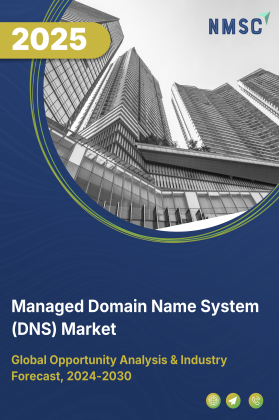Cloud-Locked Semiconductors Market by Type (Digital Security Semiconductors and Others) by Cloud Ownership Model (Cloud-Provider-Owned Secure Chips and Others), by Semiconductor Product Type (Secure Microcontrollers & SoCs and Others), by Cloud Dependency Level (Fully Cloud-Locked, Cloud-Integrated but Flexible, and Others), by Deployment (Cloud-Based, On-Premises/Hybrid), and by Others – Global Opportunity Analysis and Industry Forecast, 2025–2030
Industry Outlook
The global Cloud-Locked Semiconductors Market size was valued at USD 1.62 billion in 2024, with an estimation of USD 1.84 billion in 2025 and is predicted to reach USD 3.52 billion by 2030 with a CAGR of 13.8% from 2025-2030.
The market is experiencing strong growth driven by the rapid adoption of IoT devices, increasing integration in the automotive sector, and expanding applications in healthcare. These semiconductors are essential for enabling secure data transmission, real-time analytics, and efficient storage across connected ecosystems.
Rising demand from autonomous vehicles, telemedicine, wearable health devices, and AI-powered diagnostics is fueling adoption. However, the market faces challenges from growing cybersecurity risks and the complexity of securing vast cloud-based infrastructures.
Looking ahead, the integration of quantum computing offers significant opportunities, enabling faster processing, advanced cryptography, and support for next-generation applications, positioning the market for substantial long-term growth.
Rising Adoption of IoT Devices Drives the Global Cloud-Locked Semiconductors Market Growth
The rapid increase in Internet of Things (IoT) device connections fuels the demand for cloud-locked semiconductors to enable efficient data processing, secure transmission, and real-time analytics. These semiconductors play a critical role in ensuring seamless communication between IoT devices and cloud platforms by supporting data encryption, storage optimization, and high-speed data transfer. According to the Global System for Mobile Communications (GSM), the number of IoT devices connected globally reached 15.1 billion in 2021 and is projected to rise to 23 billion by 2025, significantly driving the cloud-locked semiconductors market growth.
Increasing Integration of Cloud Locked in the Automotive Sector Fuels the Cloud-Locked Semiconductors Market Demand
The automotive industry is witnessing rapid technological transformation with the adoption of autonomous driving and connected car technologies. These advanced features rely on secure and real-time data communication between vehicles and cloud platforms, driving the need for cloud-locked semiconductors.
According to the International Energy Agency (IEA), electric car sales topped 17 million worldwide in 2024, rising by more than 25% compared to 2023, with the additional 3.5 million cars sold in 2024 alone surpassing the total sales in 2020. This surge in electric and connected vehicles intensifies the need for secure data handling, real-time analytics, and improved vehicle performance, boosting market growth.
Growing Demand in the Healthcare Industry Increases Market Growth
The healthcare sector increasingly depends on cloud-locked semiconductors for secure processing and management of sensitive patient data across telemedicine, wearable health devices, and AI-driven diagnostic tools. Rising healthcare spending further emphasizes the need for efficient data storage and secure transmission.
The U.S. Centers for Medicare & Medicaid Services (CMS) projects an 8.2% growth in national health spending in 2024 and a further 7.1% increase in 2025, highlighting the sector’s focus on technology-driven solutions to enhance data security and operational efficiency, thereby accelerating cloud-locked semiconductors market growth.
Rising Cybersecurity Risks Hinders the Market Growth
The growing risks of unauthorized access, cyberattacks, and data breaches pose significant challenges to the cloud-locked semiconductors market expansion. As more IoT devices, connected vehicles, and healthcare systems rely on cloud platforms, ensuring end-to-end security becomes increasingly complex. These threats hinder market growth by raising concerns among enterprises about data privacy, regulatory compliance, and potential financial losses associated with cyber incidents.
Integration of Quantum Computing Creates Future Opportunities for the Market
The integration of quantum computing into cloud-based semiconductor solutions presents major growth opportunities. Quantum processors dramatically enhance cloud infrastructure by improving data processing speed and enabling breakthroughs in cryptography, artificial intelligence, and big data analytics.
As demand rises for semiconductors capable of supporting quantum algorithms and managing complex cloud applications, manufacturers will have the chance to develop next-generation chips tailored to these emerging technologies, unlocking new revenue streams in the coming years.
Market Segmentations and Scope of the Study
The market report is segmented by type, ownership model, product type, cloud dependency, deployment, application, end-user, and region. By type, it includes digital security semiconductors, analog security controllers, and memory devices with integrated security such as encrypted DRAM and secure NAND. Based on ownership model, the market is divided into cloud-provider-owned secure chips and independent semiconductor vendors. Product types cover secure MCUs, secure elements, TEEs, and security accelerators. By dependency, it is segmented into fully cloud-locked, cloud-integrated but flexible, and hardware security modules. Deployment spans cloud-based and hybrid models. Applications include datacenter, IoT, mobile, and industrial security. End-users cover IT, healthcare, automotive, retail, energy, and finance across global regions. Regional coverage includes North America, Europe, Asia-Pacific, and Rest of the World (RoW).
Geographical Analysis
In North America, the expansion of the industrial automation sector is a major driver for the cloud-locked semiconductors market share, as automated systems increasingly rely on IoT devices and cloud-based infrastructure for seamless operations and predictive maintenance. The CHIPS and Science Act further strengthen the region’s semiconductor ecosystem by boosting domestic production, driving innovation, enhancing national security, and reducing dependency on foreign sources, ensuring the U.S. remains a global technology leader.
In Asia-Pacific (APAC), rapid growth in the electric vehicle (EV) sector is fueling demand for cloud-locked semiconductors industry. EVs rely on cloud-based platforms for navigation, battery management, autonomous driving, real-time diagnostics, and performance optimization, driving manufacturers to adopt advanced semiconductor solutions. According to the International Energy Agency (IEA), electric car sales in China reached 10.1 million in 2024, up from 8.1 million in 2023, a 24% growth, highlighting the increasing need for secure and efficient cloud semiconductor systems.
In Europe, the focus on digital sovereignty is encouraging local semiconductor production to reduce reliance on non-European tech providers and ensure data privacy and security. Significant investments in 5G networks, AI research, and smart city projects are driving the demand for advanced semiconductor solutions.
Since the 2024 5G Observatory report, interest in EU public funding for 5G and 6G remains strong. The European Commission and the Smart Networks and Services Joint Undertaking (SNS JU) have allocated over USD 327 million in additional funding to support advanced research, infrastructure deployment, and innovation in next-generation networks, through several funding calls of SNS, Horizon Europe (Cluster 4), and the Connecting Europe Facility (CEF). These initiatives are expected to further accelerate semiconductor adoption across industries.
In the Rest of the World (ROW), emerging markets in Latin America, Africa, and the Middle East are driving adoption of cloud-locked semiconductor solutions through investments in smart infrastructure, IoT-enabled industrial projects, and urban modernization initiatives. As digital economies develop in these regions, the demand for secure and high-performance semiconductor solutions is expected to grow, creating new opportunities for global manufacturers to expand their footprint.
Strategic Innovations Adopted by Key Players
Key players in the cloud-locked semiconductors industry are driving market growth through custom chip launches, proprietary silicon development, and advanced security innovations.
-
In September 2025, Microsoft rolled out its own security ASIC, the Azure Integrated HSM, embedded across all Azure servers to meet FIPS 140-3 Level 3 standards. It provides local tamper resistance, reduced latency through on-chip cryptographic functions, and forms part of a broader “Secure by Design” initiative that includes Azure Boost, a silicon root of trust module, and post-quantum cryptography support.
-
In August 2025, Microsoft introduced two custom chips: a security-focused HSM chip and a Data Processing Unit (DPU) to enhance AI workload handling. These chips aim to reduce reliance on third-party silicon while delivering improved performance and efficiency in Azure environments.
-
In December 2024, AWS unveiled Trainium3 (with up to 4× the performance of its predecessor) and announced Project Rainier, a massive AI supercomputer built with its own AI chips, signaling a shift toward proprietary silicon.
-
In November 2024, Microsoft introduced two custom chips: a security-focused HSM chip and a Data Processing Unit (DPU) to enhance AI workload handling. These chips aim to reduce reliance on third-party silicon while delivering improved performance and efficiency in Azure environments.
Key Benefits
-
The report provides quantitative analysis and estimations of the sector from 2025 to 2030, which assists in identifying the prevailing cloud-locked semiconductors market opportunities.
-
The study comprises a deep-dive analysis of the current and future cloud-locked semiconductors market trends to depict prevalent investment pockets in the sector.
-
Information related to key drivers, restraints, and opportunities and their impact on the cloud-locked semiconductors market is provided in the report.
-
Competitive analysis of the key players, along with their market share is provided in the report.
-
SWOT analysis and Porters Five Forces model is elaborated in the cloud-locked semiconductors market study.
-
Value chain analysis provides a clear picture of the roles of stakeholders.
Cloud-Locked Semiconductors Market Key Segments
By Type
-
Digital Security Semiconductors
-
Secure Microcontrollers & SoCs
-
Trusted Execution Environments
-
Crypto Co-Processors & Secure Elements
-
-
Analog Security Controllers
-
Memory Devices with Security Integration
-
Encrypted DRAM
-
Secure NAND storage
-
By Cloud Ownership Model
-
Cloud-Provider-Owned Secure Chips
-
Independent Semiconductor Vendors
By Semiconductor Product Type
-
Secure Microcontrollers (MCUs) & SoCs
-
Secure Elements (SE) & Crypto Co-Processors
-
Trusted Execution Environment (TEE) / Enclave Processors
-
Security Accelerators & Custom ASICs
By Cloud Dependency Level
-
Fully Cloud-Locked
-
Cloud-Integrated but Flexible
-
Hardware Security Modules & Authenticators
By Deployment
-
Cloud-Based
-
On-Premises / Hybrid
By Application
-
Cloud Datacenter & Enterprise Security
-
IoT & Edge Device Security
-
Mobile & Consumer Device Security
-
Industrial & Automotive Security
By End-User
-
IT & Telecommunications
-
Healthcare
-
Automotive
-
Retail
-
Energy & Services
-
Financial Services
By Region
-
North America
-
The U.S.
-
Canada
-
Mexico
-
-
Europe
-
The UK
-
Germany
-
France
-
Italy
-
Spain
-
Denmark
-
Netherlands
-
Finland
-
Sweden
-
Norway
-
Russia
-
Rest of Europe
-
-
Asia-Pacific
-
China
-
Japan
-
India
-
South Korea
-
Australia
-
Indonesia
-
Singapore
-
Taiwan
-
Thailand
-
Rest of Asia-Pacific
-
-
RoW
-
Latin America
-
Middle East
-
Africa
-
Key Players
-
Microsoft
-
Qualcomm
-
Infineon Technologies
-
Renesas Electronics
-
Intel Corporation
-
Arm Limited
-
Amazon Web Services, Inc.
-
Google (Cloud)
-
Broadcom
-
MediaTek
-
Microchip Technology
-
Texas Instruments
-
Yubico
Report Scope and Segmentation
|
Parameters |
Details |
|
Market Size in 2025 |
USD 1.84 Billion |
|
Revenue Forecast in 2030 |
USD 3.52 Billion |
|
Growth Rate |
CAGR of 13.8% from 2025 to 2030 |
|
Analysis Period |
2024–2030 |
|
Base Year Considered |
2024 |
|
Forecast Period |
2025–2030 |
|
Market Size Estimation |
Billion (USD) |
|
Growth Factors |
|
|
Countries Covered |
28 |
|
Companies Profiled |
15 |
|
Market Share |
Available for 10 companies |
|
Customization Scope |
Free customization (equivalent up to 80 working hours of analysts) after purchase. Addition or alteration to country, regional, and segment scope. |
|
Pricing and Purchase Options |
Avail customized purchase options to meet your exact research needs. |

















 Speak to Our Analyst
Speak to Our Analyst

























